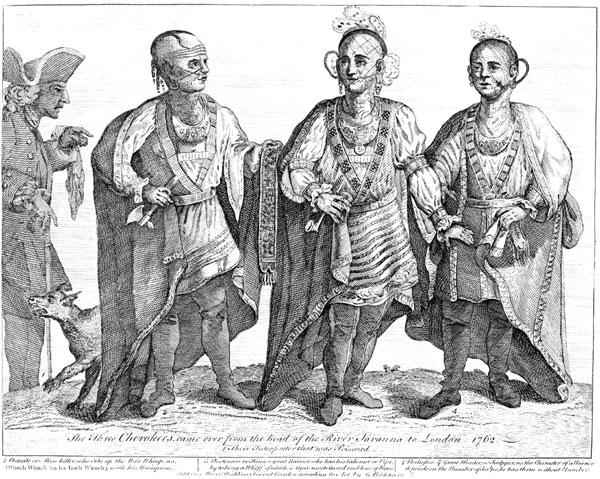Before Columbus, before the streets of Paris were paved in Europe, a sophisticated Native civilization covered nearly six square miles near the Missisippi River. There were houses, plazas, agriculture, and a central mound 1,000 feet long, 800 feet wide, and 100 feet high with 4 terraces. It was protected by a 2-mile-long stockade with guard towers.
Those who would become the people called “Cherokee” moved Southeast. When they first came in contact with the white man (DeSoto in 1540), they claimed some 135,000 square miles of territory covering parts of eight present-day states: North Carolina, South Carolina, Georgia, Alabama, Tennessee, Kentucky, Virginia and West Virginia.
Spiritual activities such as healing, purification, and prayer were presided over by the hereditary and priestly “white” group of elders representing the seven clans. Younger men made up the “red” group and conducted the dirty work of war. The white priests held power over the warriors because reintegration into normal village life after battle required purification.
The Ani-Kutani priests were hated for their oppression and abuse of power. At some point the wife of a young warrior was abducted and violated by a priest while the warrior was away at battle. In the resulting uprising all the Ani-Kutani were massacred. They were eventually replaced by medicine men (didanvwisgi) whose qualifications were based more on individual knowledge and ability than heredity.
As war and disease shrank their numbers, the Cherokee were concentrated in today’s western North Carolina, eastern Tennessee and northern Georgia. They had “Middle Towns” along the Little Tennessee River, “Valley Towns” along the Hiwassee and Valley Rivers, and the “Out Towns” on the Tuckasegee and Oconaluftee Rivers. Each town had it’s own leaders.
In the early 1700’s a man named Alexander Cuming met with the Cherokee to reinforce their alliances with the English. Cuming was able to bring all of the Cherokee chieftains together. As a sign of their commitment, they gave him the “Crown of Tenasi” to lay at the feet of King George in England. Cuming crowned one of the chieftains called Moytoy as “Emperor of the Cherokee”. Then Cuming, an interpreter, and six of the Cherokee chiefs sailed from Charleston to England in the spring of 1730. They spent four months there. Eight years later a smallpox epidemic hit the Cherokee Nation killing thousands.
By the “Treaty of New Echota” in 1835, all lands east of the Mississippi River were ceded to the Federal Government. (Of the 40 treaties executed with the Cherokees, the Federal Government chose to break each and every one.) As far back as 1782, a group of Eastern Cherokee who fought with the British in the Revolution petitioned the Spanish for permission to settle west of the Mississippi, which was granted. A group of Eastern Cherokee moved in 1794 into the St. Francis River valley in present-day southeastern Missouri. It is probable that there were already Cherokee settled in the Missouri area. Records of how many people, and when, moved “West” are limited. Due to earthquakes and flooding in Missouri, around 1812, most of the Cherokee in Missouri moved into present-day northwestern Arkansas.

